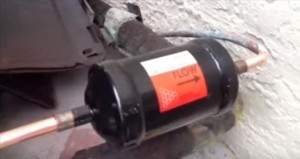
Most HVAC professionals would agree that moisture is the single most detrimental factor in a refrigeration system.
A unit can stand only a small amount of water. For this reason, the majority of refrigeration and air conditioning systems contain driers.
Several designs of heat pumps have two driers. Liquid line driers have been used in refrigeration systems for many years.
A drier’s primary function is to filter and remove moisture from the refrigerant.
HVAC Liquid Line Driers Functions
- Moisture removal
- Filtering
- Acid removal
Moisture in a refrigeration system is a contributing factor in the formation of acids, sludge, and corrosion. Hydrochloric and hydrofluoric acids are formed by the interaction of halocarbon refrigerants and small amounts of moisture.
Moisture in a refrigeration system can cause a multitude of difficulties varying from expansion valve freeze-up to possible hermetic motor compressor burnout.
In large amounts, water can directly produce mechanical malfunctions. It is important to remove quickly and completely any moisture and any acid or sludge that may have formed from a refrigeration system.
Over the years, refrigeration systems have become more complex, and driers are required to perform functions other than drying.
How to Select a Liquid Line Drier
- Type and amount of refrigerant
- Refrigeration system tonnage
- Line size
- Allowable pressure drop
When the refrigerant, line size, and application a known, the drier is generally selected on the basis of recommended capacities, which take into account both drying and refrigerant flow capacity.
The flow an moisture capacity information is published by the liquid line drier manufacturer in tabular form for all popular refrigerants.
Types Of Liquid Line Driers
There are two general types of liquid line driers in use. They are the straight-through sealed type, and the angle replaceable core (replaceable-cartridge) type.
Another type of liquid line drier has been especially developed for use on heat pump systems.
This filter-drier provides system protection in both heating and cooling cycles with one filter-drier. These driers are equipped with internal check valves that allow refrigerant flow and filtration in either direction.
The external check valves normally used on heat pump systems are eliminated. These units reduce system complexity and cost while providing effective removal of moisture, acid, and solid contaminants.
Suction Line Filter
The proper suction line filter will protect the refrigeration compressor by collecting all foreign matter and preventing it from entering the compressor where it could damage the highly machined and polished internal working parts.
The suction line filter should be installed as close as possible to the compressor prior to system start-up. When installed in this manner, it will remove foreign particles that are present even when the best installation procedures are carefully followed.
Selection of Suction Line Filter
The following factors influence the selection of the correct size of filter:
- Type of refrigerant
- Suction line size
- Allowable pressure drop
- Application (low temperature, commercial refrigeration, or air conditioning)
When the refrigerant type, line size, and application are known, the filter is selected on the basis of refrigerant flow capacity expressed in tons.
Flow capacity information is published by the suction line filter manufacturer in tabular form for all popular refrigerants.
What is the acceptable level of moisture (ppm) in a new chiller system using R134a refrigerant?
We have a situation where there is obviously moisture present and we are trying to determine what the industry acceptable level is. Is there a standard? Where can I find it?